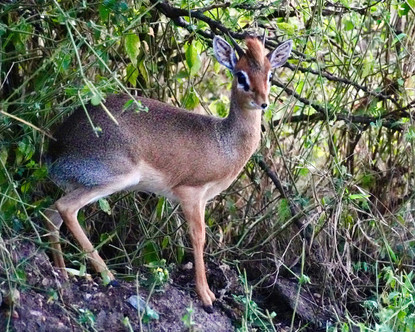MASAI MARA: NDOTO SAFARI
- chuckmeltzer
- Jun 29
- 6 min read
Updated: Sep 3
We embarked on our first safari to Masai Mara. We took a small propeller plane to reach there; we were the second stop. However, when the plane landed on a dirt runway for the first stop, we got a flat tire. Who knew airplanes can get blow outs? Fortunately, they had a spare tire. We disembarked, the pilot and his crew jacked up the plane, and in under half an hour, we were back on our way to our destination.

We were greeted by a driver from the Offbeat Ndoto Camp, where we would spend the next four days. Offbeat Ndoto is a small camp founded in 2021, featuring only 5 tents, which makes it very intimate and unique. I'll share more about our camp and the kind and generous staff later, but first, I'd like to describe our journey in.
The roads are all dirt, with some being rockier and having deeper divots and "potholes" than others. Our open-air Land Cruiser was a highly capable off-road vehicle, embodying what an SUV is meant for; it made me question why so many people in the States love their SUVs when off-road driving is not common; we drive a station wagon back home.
On this initial drive, I had my first major safari experience when we came across a male lion, clearly full after his meal, as he was guarding the remains of his lunch—a zebra with an empty thorax and abdominal cavity. Some spotted hyenas and jackals were trying to get a piece of the action, but the lion wasn't allowing it and kept them at bay. Sitting in an open-air vehicle just 15 feet from a lion can be quite nerve-wracking if you've never experienced it before. Apparently, as long as you stay in the vehicle, they don't see you as prey and leave you alone. It's only if you step out of the vehicle that you're perceived as a predator, which is not a good situation if you're unarmed. This sighting was an incredible one to witness on our way to camp.
When we arrived at the camp, the staff, including the camp manager, several guides, and our tent "butler," greeted us warmly. We enjoyed our lunch at a table set beneath a tree overlooking a stream teeming with birdlife. The meal was delicious, and the setting was incredibly beautiful and peaceful. There were no ambulance sirens, shouting homeless individuals, or other noises typical of urban life—just the sounds of birds and the occasional grunts from nearby hippopotami.
Our tent was spacious and well-equipped, featuring running hot water, a large shower, a functioning toilet, plenty of electrical outlets, and front flaps that zip open and closed to keep out nocturnal critters. To reach the main tent for dinner, we had to signal with a light from our tent to be escorted safely, as some wildlife might be around in the evening. We dined at 8 every night, and the meals were delightful, with a hint of French influence in their preparation. The camp grows much of its own produce in its kitchen garden, allowing us to enjoy fresh and delicious vegetables.
Fresh air and light birdsong made for a perfect sleeping environment.
Of course, we are in Africa, so there was the occasional lion roar in the distance, a trumpeting elephant and the sound of a grunting hippo making its rounds of our tents. Only one night was a bit more annoying, and the sound was not due to the wildlife, but to a church miles away that had a Friday night service which involved drums banging at midnight and again at 3am; initially I thought the drums were being used at the camp to get some of the wildlife away from our tents, and only found out the next morning it was coming from this church.





There were two safaris each day, the first one heading out at 630am returning around 11am, and the second one at 430pm and back by 700pm. On the morning sojourn, we stopped for breakfast around 830am served on campaign wood tables usually on a savannah amidst the less threatening animals. Breakfast was a full-on British breakfast with granola, yogurt, great local Acai honey, pancakes, sausage, bacon and all I kept thinking was how will I not gain weight on this trip while eating all that was offered. The downside to safari in the wild is that you cannot go for a walk or run on your own, which means we are not really exercising and the limit of our activity is sitting in the back of a Land Cruiser. On the evening safari, we usually take a break before sunset for a cocktail, some nibbles, and then continued for a bit more exploration….so sensible!!!
The main goal of any safari is to see the “big five”; elephants, rhino, Cape Buffalo, lions and leopards. In earlier times, this goal was for hunters who would shoot them for their trophies. Now we only shoot them with our cameras, although there are still some safaris in Tanzania and elsewhere where they use guns, but not in Kenya. We probably saw about 20 lions, dozens of buffalo, and many elephants. We expect to round out our “big five” later in the month when we got to a different camp.


We always had a Land Cruiser designated just for us and a driver and guide who were very familiar with the conservancy. We drove across numerous fields and dirt roads in search of the big five. We also crossed several streams with water spraying as we forged our way across. My spine has been completely realigned from all the bumps we encountered while navigating Masai Mara. One of our guides noted that the bumpy ride is referred to as the “Masai Massage”.
One of the great aspects of staying at a camp in a conservancy is that a portion of the money spent on our booking at Offbeat Ndato goes back to support the Masai community living and working there, unlike other camps that may not benefit local people. Everyone involved in the camp took excellent care of us. The drivers, guides, food servers, and managers were all kind and went above and beyond to make our stay truly special.
While I have not seen all the “big five”, I have not been deprived. The various animals we have seen include many that I never even knew existed. The experience is mind blowing to see first-hand what the lineup might have been to get on Noah’s Ark. There are birds everywhere and the birdsong fills the gap left from the lack of cars and city noise.
Here is the list of some of the wildlife I have observed so far: Spotted hyena, Striped hyena, Hippopotamus, Crocodile, Leopard tortoise, Zebra, Giraffe, Warthog, Wildebeest, Thompson’s Gazelle, Hartebeest, Topi, Eland, Impala, Waterbuck, Baboon, Vervet monkey, and Dikdik.
The lions were intimidating, but once I realized that they are not interested in us, I became more relaxed around them and interested in observing the animal behavior. On one of the afternoon trips, it was after dark and we had stopped to see if we might still find a leopard, when 8 young lions walked by us in single file, which despite what I said above, caused me to have a momentary sense of impending doom!!! And on that same outing, we encountered another 3 young lions trying to dig out the underground pen of a Warthog, which are essentially the boars of Africa. It was interesting to watch these young guys pawing out dirt, sharing in the project, taking breaks and being like any other adolescents fooling with each other. The only other lion experience was another zebra feast, this one fresher and they were in the process of disemboweling the animal. I realize this is all about what nature does, but it was a bit disquieting to observe the brutality of it. Buying meat nicely packaged from the butcher is so much more civilized!!!
To sum up my takeaways from my first week in Kenya, I have been wowed by the raw beauty of the Masai Mara with its wide savannahs and bush, and the tremendous variety and volume of animals and birds we encountered. I cannot imagine seeing this wildlife, specifically all the animals anywhere else in the world. I think the British influence remains very strong in the gentle manners and the fact that English is widely spoken despite the fact that Swahili is the national language. People are very friendly and laid back. And to top it off, the weather is consistently beautiful year round.




























































































Comments